Staying Warm During Cold Weather Photography
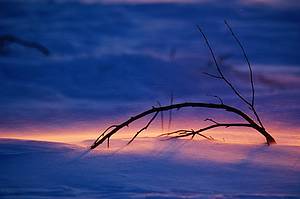
Pink sunset backlights blowing snow on the tundra. © Patrick J. Endres
To enjoy photographing in cold-weather conditions you a dress regime that keeps you warm enough to function and enjoy the experience. Alaska’s winter offers a unique angle of light, soft pastel colors, a serene simplicity, and sometimes extremely cold temperatures in the Interior and Arctic regions. Here are some tips to help you stay comfortable and functional while photographing in the cold.
Staying Warm
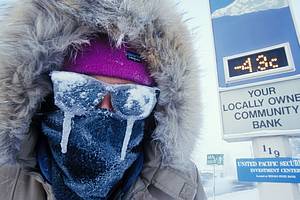
Sometimes you can convince your friends to do crazy things for a photo. I used a spray bottle of water to make the icicles on these sunglasses. © Patrick J. Endres
There are two main ways to stay warm:
- Internal Heat: Generating heat through exertion and retaining it with external insulation and clothing.
- External Heat: Absorbing heat from external sources like a wood stove, chemical hand warmers, or hot fluids.
Sometimes, just adding extra insulation isn’t enough, and a supplemental heat is necessary. Personally, I’ve found a combination of both methods works best. Over the years, I’ve developed a system that keeps me reasonably warm even though I seem more prone to cold hands and feet than others.
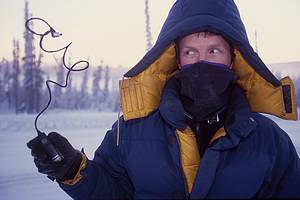
I favor thick-down parkas for the chilly winter conditions. Note that the electronic shutter release, usually soft in warm temperatures, is rigid at 40 below zero. © Hugh Rose
Layer Essentials
For Alaska’s sub-zero temperatures–when standing still waiting perfect lighting or for the northern lights to appear–I prioritize insulation over layering. While layering is critical when engaged in activities that generate varying amounts of body heat, the deep cold conditions require loft and warmth, which down garments provide best.
I start with a merino wool base layer (soft and moisture-wicking) and avoid cotton altogether. Over this, I wear a mid-weight shirt with a collar to protect my neck, a down sweater, and finally, a hooded down parka. For my legs, I use a similar base layer with insulated bib overalls. It’s important to avoid anything tight-fitting, as it restricts circulation and reduces warmth.
Hat and Face Mask
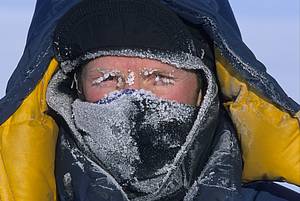
A face mask is a better option than this neck muffler due to the build up of condensation and frost from breathing. © Patrick J. Endres
Nothing beats my beaver hat for warmth, though a well-insulated hood or a smaller wool or fleece hat may suffice. I also use a face mask or neck muffler for additional protection. My merino wool neck muffler is soft, warm, and comfortable but tends to collect frost from breath condensation.
For longer outings, I prefer a lightweight face mask with breathing holes and a nose guard. This minimizes frost buildup and dries quickly, offering a practical alternative to heavier materials like neoprene.
Footwear
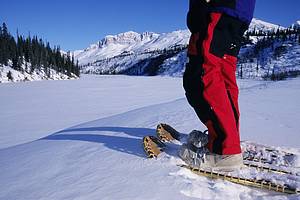
Bunny boots are a tried and true, although heavy, warm winter boot choice. © Patrick J. Endres
Warm boots are critical, but many are overrated in their insulation claims. Choose boots with enough room to wiggle your toes, even with thick socks, as tight footwear can reduce warmth. Look for boots with a substantially insulated soles and consider adding interior felt insoles for extra insulation. They can also be easily removed to dry in between outings.
Military-style “Bunny boots” are a favorite in Alaska—heavy and unattractive but exceptionally warm. Cabela’s Trans-Alaska boots are well insulated and waterproof, I get a size or two larger so they will accommodate a felt liner and thicker socks. Removable liners are particularly useful for drying at the end of the day.
Gloves and Mittens
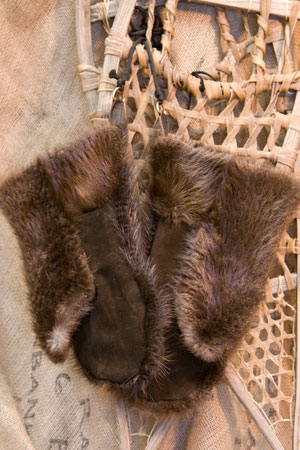
Beaver mitts are large enough to fit a glove inside and have a soft enough leather pad to let me operate my camera. © Patrick J. Endres
Keeping hands warm is my biggest challenge. My system includes thin, loose-fitting wool gloves as a base layer. For temperatures below -10°F, I add medium-weight fleece gloves, both of which fit inside large, fur-lined mittens. Beaver mittens, with their supple leather palms, are ideal because they allow me to operate my camera without removing them.
For added warmth, I place chemical hand warmers inside the mittens. When I need extra dexterity, I briefly remove the mittens and warm my hands again afterward. In extreme cases, I use the mountaineer’s trick of “windmilling” swinging my arms to force blood into my hands. It’s not glamorous, but it works.
Equipment Considerations
Many of today’s current digital cameras are impressively durable in extreme cold, functioning even at -30°F to -40°F. While the LCD screen slows down, it remains operational. Batteries, however, drain quickly. I keep spares in my parka and rotate them as needed. SanDisk Extreme cards also perform reliably in freezing conditions.
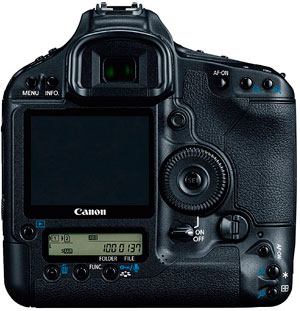
The wheel on the back of the Canon cameras is a perfect design element for operating the camera with mitts or gloves. It is easy to turn with the thumb or finger and thereby control exposure settings.
To avoid frostbite, I’ve padded any metal parts of my camera that touch my face with moleskin. Additionally, if I anticipate long waits, I remove the battery and flash card, storing them in my parka pocket while leaving the camera on the tripod.
